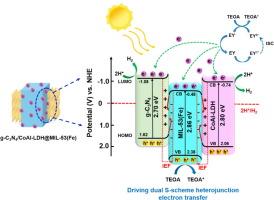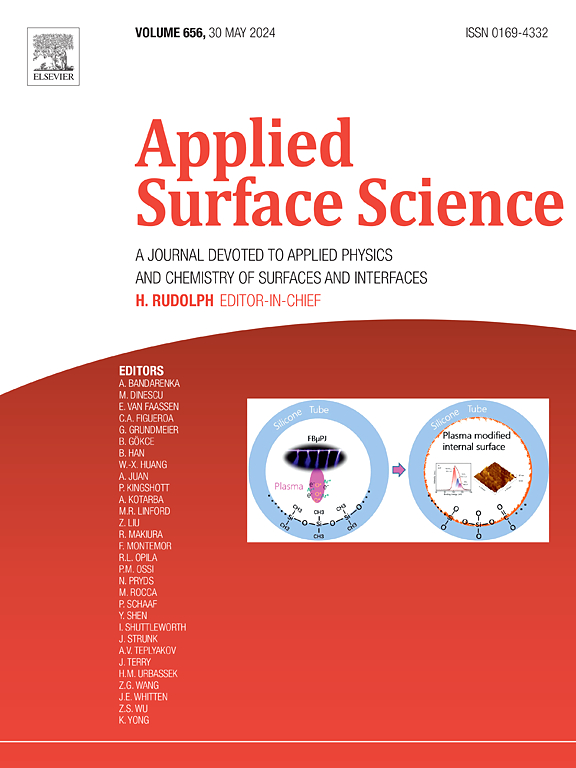Construction of dual S-scheme heterojunctions g-C3N4/CoAl-LDH@MIL-53(Fe) ternary photocatalyst for enhanced photocatalytic H2 evolution
IF 6.3
2区 材料科学
Q2 CHEMISTRY, PHYSICAL
引用次数: 0
Abstract
The construction of dual-type heterojunction photocatalysts for efficient hydrogen (H2) production through water splitting is a promising method in the field of photocatalysis. In this work, a ternary photocatalyst of g-C3N4/CoAl-LDH@MIL-53(Fe) with a dual S-scheme heterojunction was prepared for the first time. This composite demonstrates outstanding photocatalytic performance under visible light, reaching as high as H2 production rate of 1222.2 µmol·g−1·h−1 for the optimized g-C3N4/CoAl-LDH40@MIL-53(Fe)(60), which was 7.1 times higher than that of the single heterojunction CoAl-LDH40@MIL-53(Fe). The dual heterojunction design narrows the bandgap, increases photocurrent density, and reduces photoluminescence intensity, thereby improving visible light absorption and charge carrier separation. MIL-53(Fe) serves as excellent electron donor, while CoAl-LDH and g-C3N4 act as electron acceptors, which synergistically facilitate electron transfer in CoAl-LDH@MIL-53(Fe). Furthermore, the tight contact interface of g-C3N4/CoAl-LDH@MIL-53(Fe) establishes a dual S-scheme charge carrier transfer pathway with abundant active sites which are pivotal for the efficient separation of electrons and holes. A plausible mechanism for the photocatalytic water splitting to H2 was proposed, elucidating the role of the dual S-scheme heterojunction in boosting H2 production. Current work provides a promising strategy for fabricating dual heterojunction photocatalyst to achieve efficient photocatalytic H2 evolution.


构建双 S 型异质结 g-C3N4/CoAl-LDH@MIL-53(Fe) 三元光催化剂以提高光催化 H2 演化能力
构建双型异质结光催化剂,通过水分裂高效制氢(H2),是光催化领域一种前景广阔的方法。本研究首次制备了具有双 S 型异质结的 g-C3N4/CoAl-LDH@MIL-53(Fe) 三元光催化剂。这种复合材料在可见光下具有优异的光催化性能,优化后的 g-C3N4/CoAl-LDH40@MIL-53(Fe)(60) 的 H2 产率高达 1222.2 µmol-g-1-h-1,是单一异质结 CoAl-LDH40@MIL-53(Fe) 的 7.1 倍。双异质结设计缩小了带隙,提高了光电流密度,降低了光致发光强度,从而改善了可见光吸收和电荷载流子分离。MIL-53(Fe) 是优良的电子供体,而 CoAl-LDH 和 g-C3N4 则是电子受体,它们协同促进了 CoAl-LDH@MIL-53(Fe) 中的电子转移。此外,g-C3N4/CoAl-LDH@MIL-53(Fe)的紧密接触界面建立了双 S 型电荷载流子转移途径,其丰富的活性位点对电子和空穴的高效分离至关重要。该研究提出了光催化水分离为 H2 的合理机制,阐明了双 S 型异质结在提高 H2 产量方面的作用。目前的工作为制造双异质结光催化剂以实现高效光催化 H2 演化提供了一种前景广阔的策略。
本文章由计算机程序翻译,如有差异,请以英文原文为准。
求助全文
约1分钟内获得全文
求助全文
来源期刊

Applied Surface Science
工程技术-材料科学:膜
CiteScore
12.50
自引率
7.50%
发文量
3393
审稿时长
67 days
期刊介绍:
Applied Surface Science covers topics contributing to a better understanding of surfaces, interfaces, nanostructures and their applications. The journal is concerned with scientific research on the atomic and molecular level of material properties determined with specific surface analytical techniques and/or computational methods, as well as the processing of such structures.
 求助内容:
求助内容: 应助结果提醒方式:
应助结果提醒方式:


